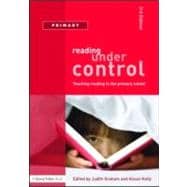
Note: Supplemental materials are not guaranteed with Rental or Used book purchases.
Purchase Benefits
Looking to rent a book? Rent Reading Under Control: Teaching Reading in the Primary School [ISBN: 9781843124610] for the semester, quarter, and short term or search our site for other textbooks by Graham; Judith. Renting a textbook can save you up to 90% from the cost of buying.
| List of illustrations | p. viii |
| Notes on contributors | p. ix |
| Preface | p. xi |
| Acknowledgements | p. xiv |
| How We Got to Where We are | p. 1 |
| Introduction | p. 1 |
| Literacy | p. 1 |
| What is reading? | p. 3 |
| Models of reading | p. 3 |
| Historical overview | p. 6 |
| Learning styles | p. 11 |
| Current government documentation | p. 12 |
| Conclusion | p. 13 |
| Reading Differences, Reading Diversity | p. 14 |
| Introduction | p. 14 |
| The gender gap | p. 14 |
| Children learning and using English as an additional language (EAL) | p. 17 |
| Using ICT: opportunities for 'real' reading and writing | p. 21 |
| Creativity and the English curriculum | p. 23 |
| Getting to Grips with Phonics | p. 26 |
| Introduction | p. 26 |
| The phonics seminar | p. 27 |
| The independent review of the teaching of early reading | p. 28 |
| What teachers need to know | p. 30 |
| Using terminology with children | p. 36 |
| Teaching phonics: pace and progression | p. 36 |
| Conclusion | p. 42 |
| Glossary of terms | p. 42 |
| The Reading Journey | p. 45 |
| Early reading | p. 45 |
| From inexperienced to experienced reader | p. 50 |
| Reading Routines | p. 55 |
| Introduction | p. 55 |
| The reading curriculum | p. 55 |
| Planning and organising for reading | p. 56 |
| Shared reading | p. 57 |
| Guided reading | p. 60 |
| Independent reading | p. 67 |
| Reading aloud to children | p. 70 |
| The class reader | p. 74 |
| Drama | p. 80 |
| Reading partners/buddies | p. 81 |
| Reading one-to-one | p. 84 |
| Parental involvement | p. 87 |
| Reading Resources | p. 92 |
| What do children need to read? | p. 92 |
| Texts within the routines | p. 96 |
| Matching the child to the book | p. 108 |
| Managing and organising resources | p. 110 |
| Useful teaching resources | p. 114 |
| Monitoring and Assessing Reading | p. 118 |
| Introduction | p. 118 |
| Assessment for learning (AfL) | p. 119 |
| The cycle of observation, planning and assessment | p. 131 |
| Assessment of learning (AoL) | p. 134 |
| Managing your records | p. 139 |
| Meeting Individual Needs | p. 141 |
| Introduction | p. 141 |
| Reasons for failure to read | p. 141 |
| Characteristics of struggling readers | p. 141 |
| Characteristics of successful readers | p. 142 |
| Characteristics of gifted and talented readers | p. 142 |
| What inexperienced readers need | p. 144 |
| What inexperienced readers do not need | p. 145 |
| Formal arrangements for struggling readers | p. 145 |
| A quick checklist if a child seems to be struggling | p. 148 |
| Assessment | p. 149 |
| Meeting individual needs in and out of the classroom | p. 150 |
| Parental involvement | p. 157 |
| Conclusions | p. 158 |
| Dyslexia and Reading | p. 159 |
| Introduction | p. 159 |
| Defining the condition | p. 159 |
| Lines of enquiry into dyslexia | p. 161 |
| A case history of David in Year 2 | p. 166 |
| A case history of Gary in Year 5 | p. 170 |
| Conclusion | p. 174 |
| References | p. 175 |
| Author index | p. 188 |
| Subject index | p. 192 |
| Table of Contents provided by Ingram. All Rights Reserved. |
The New copy of this book will include any supplemental materials advertised. Please check the title of the book to determine if it should include any access cards, study guides, lab manuals, CDs, etc.
The Used, Rental and eBook copies of this book are not guaranteed to include any supplemental materials. Typically, only the book itself is included. This is true even if the title states it includes any access cards, study guides, lab manuals, CDs, etc.